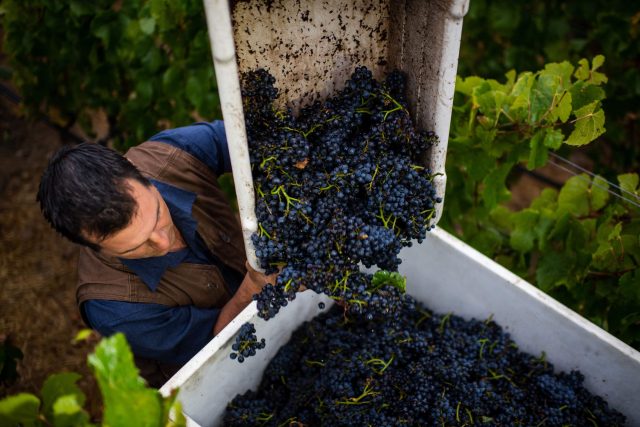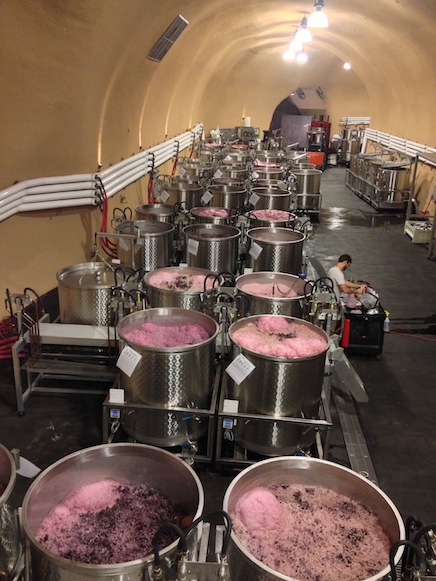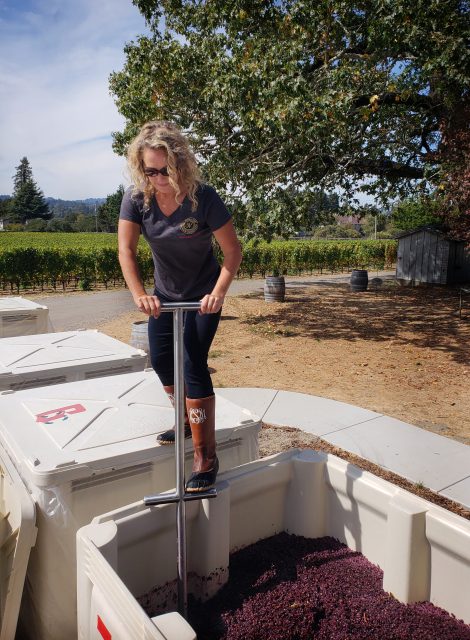This website uses cookies so that we can provide you with the best user experience possible. Cookie information is stored in your browser and performs functions such as recognising you when you return to our website and helping our team to understand which sections of the website you find most interesting and useful.
How foot treading on grapes has hopped across the Pond
In most regions of the world, industrialisation has dethroned the once-mighty foot in wine production. The humble appendage once served as the most reliable method of punching down grapes, but these days, it just gets folks from Point A to Point B. But Kathleen Willcox investigates how some are turning back to older traditions.

Records of foot stomping—a.k.a treading—can be traced back at least 8,000 years to Georgia, and it is still commonly used to make wine and port in Portugal. (It’s also still alive and well at annual, raucous foot-stomping festivals across the world that seem designed to bring in partiers, instead of make wine).
For most of the rest of the world though, instead of using their (or their interns’) feet, a two-in-one crushing and de-stemming machine is deployed to break up and submerge the cap of skins and other delicious solid grape tidbits during the red wine fermentation process, ensuring the cap doesn’t dry out.
But a growing contingent of winemakers in California who are seeking nuance, texture and deeper flavours that they say machines just can’t deliver, are also treading their white and red grapes with their feet.
Re: Foot Jam
Foot stomping grapes, like frying bacon on a 20-year-old cast iron skillet that has never seen a drop of soap, can seem romantic and a sure-fire route to flavour country to some, and a recipe for rampant bacterial infection to others.
When pressed for details on the potential ‘ick’ factor, winemakers assured me that a strict foot rinse-sterilisation-rinse program is observed before any feet make contact with grapes. One winemaker, Kathleen Inman, even takes the extra step of wearing sterilised boots.
Read on for more about why winemakers are adding this carefully calibrated step to their winemaking regimen.
Precise, Terroir-Driven Flavours
Sarah Wuethrich, winemaker at the Anderson Valley’s Maggy Hawk and most recently, Sonoma Coast’s Windracer, believes that foot stomping is the key to precise flavours.
Wuethrich joined Maggy Hawk in 2017.
“I was the assistant winemaker at Copain, and when it was purchased by Jackson Family Wines, I was asked to take on Maggy Hawk,” she says. “We used foot stomping at Copain, and I brought it to Maggy Hawk.”
Maggy Hawk’s last vintage had been in 2015, and Wuethrich was essentially given a mandate to create her own program.
“I do foot treading with all of our Chardonnay, and I have since the beginning,” she says. “I do foot treading with our Pinot Noir only on whole cluster lots.”
For the Chardonnay, she brings in the grapes whole cluster and puts them in half-ton macro bins, and she and her team gingerly foot tread the grapes just enough to break up the clusters and get some juice flowing. Then she allows the juice to stay in contact with the skins for two-three hours.
“That little bit of skin contact, plus our barrel fermentation program adds so much texture to the wine,” she says. “People talk about aromas and flavours, but what I believe makes or breaks the wine is the texture. I want to extend the length—but I don’t want cream, which is what you get in a lot of California Chardonnay.”
The classic California Chardonnay, Wuethrich explains, is creamy and opulent, a product of extended lees stirring in barrel.
Right out of the gate, her wines at Maggy Hawk earned Wuethrich acclaim, earning 95 points for the 2017 Jolie Pinot Noir from Wine Spectator. She credits her success there with her latest project at Windracer.
“They want me to do what I do there in the Sonoma Coast,” she says. “Obviously, I’m doing foot trodding there too.”
Her first Chardonnay at Windracer will probably be bottled in August and released at the end of 2024. The rest will be held. Both projects are around 2,000 cases, which, she admits, allows her the freedom to micromanage small lots.
Similar philosophy
Over at Lioco Wine, which produces 20,000 cases from Sonoma, Santa Cruz and Mendocino, the lots are bigger, but the philosophy is similar. Lioco produces Carignan, Chardonnay, Sauvignon Blanc, Pinot Noir, Valdiguie and more, but the team just focuses on Chardonnay for the foot treading program.
“California sunshine and soils provide us with such ample fruit and flavours that leap from the glass,” says Lioco’s winemaker, Drew Huffine. “And that can be lovely. But we also want acid, savory notes and salinity. We have found that foot stomping dials down the opulence and allows us to bring more of the flavours of the vineyard to the glass.”
Huffine says that he and his team trod the equivalent of about 6,500 cases of Chardonnay, which then go on to age in stainless steel.
“I have found that foot treading introduces seed and stem tannins, which create more complex, age-worthy and crystalline flavours,” he says. “And because we use stainless steel instead of ageing in oak, using the tannins that comes from the grapes themselves allows to also create a more terroir-driven wine.”
Creating Structure and Ageability
“Before machines, foot treading was the only way to make wine,” says Paul Sloan, winemaker and co-founder of Sonoma’s Small Vines, alongside his wife Kathryn. “The Industrial Revolution changed all of that.”
Sloan believes that machines work most of the time, but perhaps not quite as well as feet in the best of circumstances, and certainly not during challenging vintages. Sloan uses foot treading only with his Pinot Noir grapes.
“Some vintners find that foot treading Chardonnay brings more texture and focus, but because we do high-density plantings, we find the vineyard does that for us,” Sloan says.
Instead, Sloan focuses on foot-treading his 100% whole cluster Pinot Noir, farmed with foot treading in mind.
“We do organic dry farming, and we only harvest the highest and best whole cluster shoots,” he says. “We pick in the middle of the night, and the grapes come in at 48 to 50 degrees. They won’t start fermenting until they hit around 60.”
To keep the flavours “fresh and pure,” Sloan says they release a bit of juice with gentle foot treading.
“Kathryn and our daughter Savannah do the foot treading,” he says. “We add a layer of fruit, gently walk, add more fruit, and walk again. By doing it this way and allowing most of the berries to remain intact, we can slowly ferment the grapes over 18 to 21 days, a long drawn out process that creates incredible flavour and complexity.”
He likens his approach to chefs who opt to slow-cook their meat: if you ferment grapes at top speed, you “boil off” a lot of the flavour and aroma. It’s time consuming, and Small Vines’ size—about 3,000 cases—makes it manageable.
“Grape stomping is both an art and a science,” Sloan says. “It creates wines with more ageability and structure, in addition to nuance and complexity. These wines are by nature artisanal and small batch, meant for cellaring and aging. Bigger wineries are creating wines for immediate consumption with softer tannins. That’s not what you get here right away.”

Certain circumstances
At Inman Family Wines in the Russian River Valley, owner and winemaker Kathleen Inman stomps grapes sparingly, and only under certain circumstances.
Inman makes about 3,800 cases of still and sparkling Pinot Noir, Pinot Gris and Chardonnay, with a little room for more experimental SKUs too.
“I first tried foot treading with a special production called Whole Buncha Love,” she recalls. “I am a freak about cellar hygiene, so it isn’t even foot skin contact. It’s sanitized boots contact. I didn’t want to put the grapes through the destemmer, but I did want to break them up, so I opted for foot stomping.”
Whole Buncha Love is a blend of Zinfandel, Carignan, Charbono, Petite Sirah and Grenache. She both foot-trod and carbonically fermented the Grenache only.
“I wanted more tannins and structure, and I thought the tactile contact with the grapes would boost Grenache and create more color and structure,” Inman says.
While she is not a foot-stomping convert, she believes it’s an “effective tool in very particular situations.”
Softening Tannins
While many vintners hop on grapes to add structure, Rhys Vineyards’ winemaker Jeff Brinkman takes the opposite tack.
“Here in the Santa Cruz mountains, the wine can show as extremely tannic,” Brinkman says. “We trod our grapes twice a day for just a few minutes during the fermentation process because we think it’s the gentlest form of extraction. It also allows us to homogenize temperature within the tank. You can feel the hot and cold spots and even it out.”
Brinkman joined Rhys in 2006, two years after its founding, when it was still quite small. Now, Rhys has six estate vineyards in Santa Cruz and one in the Anderson Valley, with two facilities in Santa Cruz and the Anderson Valley built around foot stomping. They only foot trod the Pinot Noir.
“Everything we do is with foot treading in mind,” Brinkman says. “We have eight 1-ton tanks in our new facility in the Anderson Valley, and a short catwalk that connects them so you can just jump into the tank from the catwalk. We find that the human foot can be much gentler than the machine pump downs, which essentially are just hitting the cap with a big stick.”
With the Pinot, foot treading softens the tannic texture, and maintains the “balance of the wine. We find that it makes them more accessible and harmonious,” Brinkman says.
Machines are great. But for high-touch, small-batch, terroir-driven wines, humble feet still can’t be beat.


